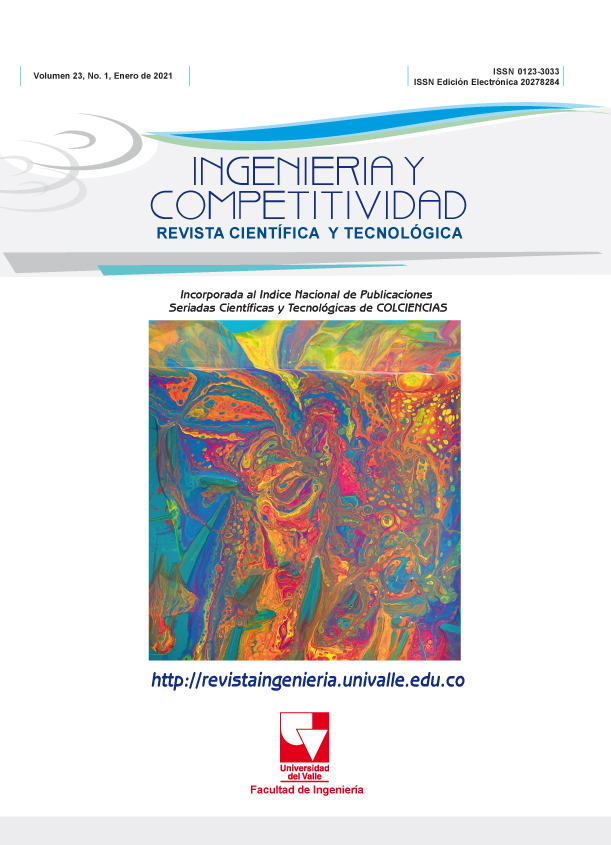Optimización de armaduras espaciales de acero utilizando algoritmos genéticos auto-adaptados: una primera aproximación
Palabras clave:
Algoritmos genéticos, Auto-adaptación de parámetros, Diseño de armaduras tridimensionales, Optimización de estructuras, Representaciones especialesContenido principal del artículo
En las últimas décadas, la optimización estructural mediante metaheurísticas ganó acogida en la comunidad científica; sin embargo, para garantizar buenos resultados se requiere una correcta selección de los parámetros de la metaheurísticas. En este trabajo se propone un algoritmo genético multi-cromosoma auto-adaptado para optimizar armaduras de acero tridimensionales. Las variables de diseño corresponden a las secciones asignadas a cada elemento en la armadura. El objetivo es la minimización del peso de la armadura, considerando desplazamientos y esfuerzos máximos como restricciones. El algoritmo propuesto se aplicó a la optimización de dos armaduras, produciendo diseños que pesan hasta un 35% menos que el mejor diseño inicial y son valores comparables al resultado obtenidos en otros trabajos. No obstante, la adaptación de los parámetros permite mayor robustez cuando se desea optimizar diferentes tipos de armadura y evita las ejecuciones del algoritmo de optimización que son necesarias para la calibración de sus parámetros.
(1) Coello-Coello CA, Rudnick M, Christiansen AD. Using genetic algorithms for optimal design of trusses. In: Proceedings of the Sixth International Conference on Tools with Artificial Intelligence TAI 94. New Orleans, LA, USA;1994:88-94. https://doi.org/10.1109/TAI.1994.346509.
(2) Sigmund O. Topology optimization: a tool for the tailoring of structures and materials. Phil. Trans. of the Royal Society A. 2000;358(1765):211-227. https://doi.org/10.1098/rsta.2000.0528.
(3) Toğan V, Daloğlu AT. An improved genetic algorithm with initial population strategy and self-adaptivee member groping. Comp. & Struc. 2008;86:11-12. https://doi.org/10.1016/j.compstruc.2007.11.006.
(4) Talaslioglu T. A new genetic algorithm methodology for design optimization of truss structures: bipopulation-based genetic algorithm with enhanced interval search. Model. and Simul. in Eng. 2009;615162.https://doi.org/10.1155/2009/615162.
(5) Erbatur F, Hasançebi O, Tütüncü I, Kılıç H. Optimal design of planar and space structures with genetic algorithms. Comp. & Struc. 2000;75(2):209-224. https://doi.org/10.1016/S0045-7949(99)00084-X.
(6) Dede T, Bekiroğlu S, Ayvaz Y. Weight minimization of trusses with genetic algorithm. Applied Soft Comp.2011;11(2):2565-2575. https://doi.org/10.1016/j.asoc.2010.10.006.
(7) Aminifar F, Aminifar F, Nazarpour D. Optimal design of truss structures via an augmented genetic algorithm. Turkish J. of Eng. & Envi. Sciences. 2013;37:56-68. https://doi.org/10.3906/muh-1203-13.
(8) Talbi E-G. Metaheuristics: From Design to Implementation. New Jersey: John Wiley & Sons,Inc.; 2009. 624 p.
(9) Smith JE, Eiben AE. Parameter Control in Evolutionary Algorithms. In: Introduction to Evolutionary Computing. Natural Co. Berlin, Heidelberg: Springer; 2003. p. 129–51.
(10) Holland JH. Adaptation in natural and artificial systems: An Introductory Analysis with Applications to Biology, Control, and Artificial Intelligence. 1st ed. London (UK): MIT Press; 1992. 211 p.
(11) Villalba JD, Laier JE. Localising and quantifying damage by means of multi-chromosome genetic algorithm. Adv in Eng Soft. 2012;50:150-157. https://doi.org/10.1016/j.advengsoft.2012.02.002.
(12) Mitchell M. An Introduction to Genetic Algorithms. London (UK): MIT Press; 1996. 221 p.
(13) Lee KS, Geem ZW, Lee SH, Bae KW. The harmony search heuristic algorithm for discrete structural optimization. Eng. Opt. 2005; 37(7):663-684. https://doi.org/10.1080/03052150500211895.
(14) Camp CV. Design of Space Trusses Using Big Bang–Big Crunch Optimization. J of Struct. Eng. 2007;133(7):999–1008. https://doi.org/10.1061/(ASCE)0733-9445(2007)133:7(999).
(15) Kripka M. Discrete Optimization of Trusses by Simulated Annealing. J. of the Braz. Soc. of Mech. Sciences & Eng. 2004; 26(2):170-173.
(16) Kaveh A, Shojaee S. Optimal design of skeletal structures using ant colony optimization. International J. of Num. Methods in Eng. 2007;70(5):563–581. https://doi.org/10.1002/nme.1898.
(17) Li L, Huang ZB, .Liu F. A heuristic particle swarm optimization method for truss structures with discrete variables. Comp. & Struc. 2009; 87(7-8):435–443. https://doi.org/10.1016/j.compstruc.2009.01.004.
(18) Sonmez M. Artificial Bee Colony algorithm for optimization of truss structures. Applied Soft Comp. 2011;11(2):2406–2418. https://doi.org/10.1016/j.asoc.2010.09.003.
(19) Degertekin SO, Hayalioglu MS. Sizing truss structures using teaching-learning-based optimization. Comp. & Struc. 2013;119:177–188. https://doi.org/10.1016/j.compstruc.2012.12.011.
Downloads

Esta obra está bajo una licencia internacional Creative Commons Atribución-NoComercial-CompartirIgual 4.0.
Los autores que publican en esta revista están de acuerdo con los siguientes términos:
Los autores ceden los derechos patrimoniales a la revista y a la Universidad del Valle sobre los manuscritos aceptados, pero podrán hacer los reusos que consideren pertinentes por motivos profesionales, educativos, académicos o científicos, de acuerdo con los términos de la licencia que otorga la revista a todos sus artículos.
Los artículos serán publicados bajo la licencia Creative Commons 4.0 BY-NC-SA (de atribución, no comercial, sin obras derivadas).

